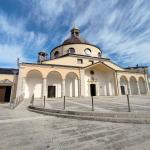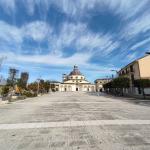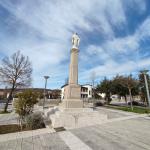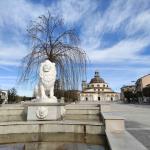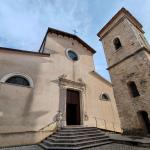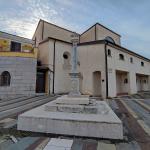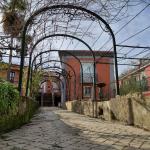The Municipality of Lioni is located within the area of Upper Irpinia. It is a town of 6,155 inhabitants, located 550 metres above sea level and 48 km from Avellino. The territory extends for 46.51 sq km and the adjoining municipalities are: Bagnoli Irpino, Calabritto, Caposele, Morra De Sanctis, Sant'Angelo dei Lombardi and Teora.
The etymology of the name seems to originate from some ancient monument in which lions were depicted; in fact, in medieval documents, Lioni is usually referred to as Casale Leonum or de Leonibus, or “farmhouse of the lions”. The inhabitants are called Lionesi and Saint Roch is their patron saint.
PLACES OF INTEREST
- Church of Santa Maria Assunta (Saint Mary of the Assumption) - Probably built on the remains of a building of the 15th century, the bell tower is the only part of the original construction that remains
- Sanctuary of San Rocco (Saint Roch)- Built after the earthquake of 1980, on the ruins of the ancient Church of the Madonna del Carmine (Our Lady of Mount Carmel), it was dedicated to the town’s patron saint, protector against the plague
- Villa Bianchi - The original building probably dates back to the late 17th century: over time it has undergone several renovations and, today, preserves the typical Art Nouveau style
- Church of the SS. Annunziata (Most Holy Annunciation) - Located in the heart of the historic centre of Lioni, it dates back to the 16th century
- Ancient water mill “La Cascata” - Built in the 19th century, it remained in operation until the 1920s and is today a historical testimony of the peasant tradition of the past
- Oppido Castle - Fortress of which only a few remains are visible
- Lombard Castrum and Roman Tomb - Masonry enclosure with a rectangular plan, with two towers leaning against the short sides
- Samnite Fortress - Remains of a city wall, perhaps belonging to a fortified village of the Samnite era
- Ethnographic, Anthropological and Territorial Museum - Housed in the school premises, it preserves about 3,500 objects
- Stele of the God Silvanus - Currently preserved in the Irpino Museum of Avellino, the stele dates back to the Domitian age
- Murals - The town is enriched by several large-scale works on the outer walls of the buildings
- Other - Church of S. Antonio da Padova (Saint Anthony of Padua), Church of S. Bernardino da Siena, Church of S. Carlo Borromeo (Saint Charles Borromeo), Church of S. Maria del Carmine al Cimitero (Our Lady of Mount Carmel at the Cemetery), Church of S. Maria del Piano (Saint Mary of the Plane), Capasso Palace, Salzarulo Palace
EVENTS
- Rites of Fire - Ancient tradition of the bonfires of the Feast of the Immaculate Conception, revived by the inhabitants of Lioni
- On the banks of the river Ofanto - Event now in its third edition in 2020, which aims to make known a place of Lioni that, for some time, was neglected
- Saint Roch Concert - Among the most anticipated events by the Lioni community, it is held on 17 August, on the occasion of the celebrations for the patron saint
TYPICAL FOOD AND PRODUCTS
- Treccia lionese - Typical local cheese in a braid shape
- Millefiori nougat - Produced by a local company for several decades, the Millefiori Oliviero, it takes up an ancient family tradition
- Caciocavallo Silano PDO - Semi-hard cheese, with spun curd, produced with milk from different breeds of cows, including Podolica
- Caciocavallo irpino di grotta PAT - Spun curd cheese, produced with milk from small and medium-sized farms, from mainly Bruna cattle, traditionally aged in caves
FUN FACTS
It is said that, in Roman times, the hill of Lioni was used as a burial place, an idea supported by the two funerary steles with the image of the buried people.
One of the stone lions, which gave the town its name, is still visible in front of the town hall.
In 2005, the Municipality of Lioni was awarded the Gold Medal for Civil Merit for the commitment shown, during the post-earthquake period of 23 November 1980, in facing the “difficult work of reconstruction of its housing fabric, as well as the rebirth of its social, economic and productive future”.
HISTORICAL NOTES
On the history of Lioni there are various and divergent narratives, although the origin of the town is well documented in medieval times, through news dating back to the period between 1289 and 1306, during which the entire Lioni territory was part of the fief of Oppido.
Towards the end of the 13th century, Oppido entered into crisis and the territory of Lioni was administered, later, by numerous families: Balvano, Gianvilla, Caracciolo and Imperiale.
The Lionese community has been devastated, over the centuries, by numerous natural disasters and pestilences. The last tragic event is dated 23 November 1980: the earthquake in Irpinia caused incredible damage to the town of Lioni, resulting in 228 victims.
In search of local identity thanks to street art, Lioni reveals itself with a poetic of reflection that is inextricably linked to the territory, to those who live it and to those who cross it
Lioni
Piazza Vittorio Emanuele III, 2, 83047 Lioni AV, Italia
Did you like it? Leave a review
Your opinion is important! It will be visible after approval by the editorial staff.
To post a comment you must be an authenticated user. Log in with Social Login
